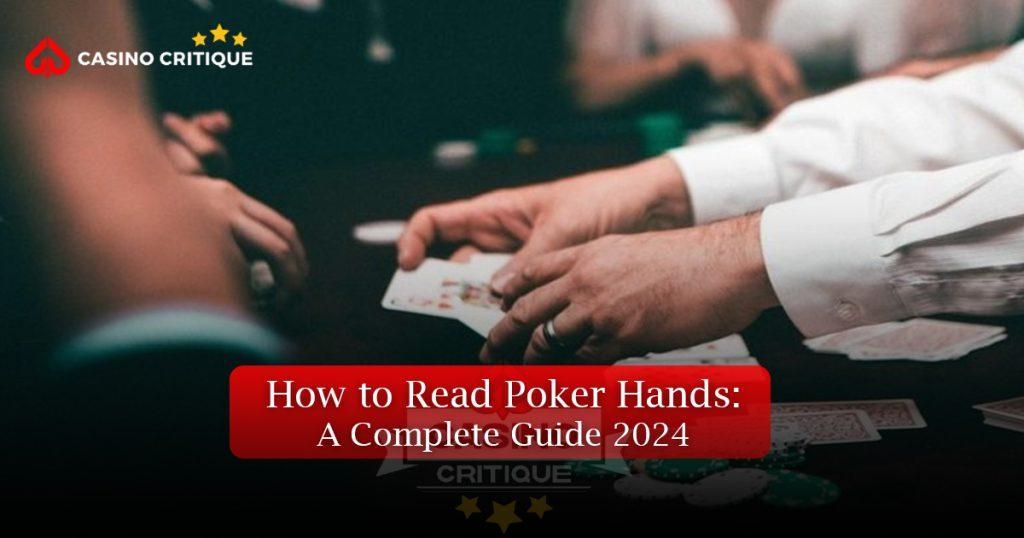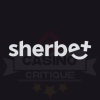
Table of Contents
Introduction
Do you want to explore How to Read Poker Hands? So lets drive!
Mastering hand reading is one of the most critical skills in poker. By learning to interpret an opponent’s potential hands, you can make smarter decisions and improve your chances of winning. This guide will take you through the art of reading poker hands, from understanding basic hand ranges to recognizing tells and timing cues in both live and online games.
Understanding the Fundamentals of Hand Reading
What is Hand Reading?
Hand reading involves estimating the possible cards your opponent holds based on their actions and position. Understanding your opponent’s range—the selection of hands they could have—is essential for making informed decisions.
Key Terms:
- Hand Range: All possible hands an opponent could have based on their actions.
- Positional Advantage: Players in later positions have more information and often play a wider range of hands.
Example:
Imagine your opponent raises from the cutoff position. Given their position, their hand range might include high pairs, strong broad way cards, and some suited connectors.
GTO and Solvers: The Modern Approach to Hand Reading
Game Theory Optimal (GTO) and Solvers
In recent years, Game Theory Optimal (GTO) strategies and solvers have become essential tools for advanced players. GTO is a mathematical approach to poker that aims to make your play unexploitable by your opponents. It involves balancing your strategies, including bluffs and value bets, so your opponents can’t easily take advantage of your tendencies.
Poker Solvers like PioSolver and GTO+ allow players to simulate a wide range of poker scenarios and determine the best strategies for specific situations. These tools can help you figure out the optimal hand ranges to use in various situations and how to adjust based on your opponent’s behavior.
For example, by using solvers, you can learn how to adjust your hand ranges in real-time during a game, ensuring that you are playing the most optimal strategy possible based on the board texture and your opponent’s actions.
Hand Equity: Calculating the Odds
What is Hand Equity?
Hand equity is the probability of your hand winning against your opponent’s potential range of hands as the community cards are revealed. As you progress through a hand, your hand equity changes based on the community cards, which helps guide your decisions.
For instance, if you’re holding AK and the flop comes 10♠, J♦, 2♣, your hand equity changes as the next cards (turn and river) are revealed. Calculating your equity allows you to assess whether you should bet, raise, or fold.
Example Scenario: Imagine you’re in a heads-up situation with AQ. The flop comes K♣, 9♠, 3♦. Your opponent might be holding Kx (a King), which gives them top pair, while you only have ace-high. Calculating your hand equity at this point can tell you that you’re a substantial underdog. This will influence whether you choose to continue with your hand or fold.
By integrating hand equity calculations into your hand-reading process, you can make more informed decisions, especially in tricky situations.
Player Typing and Psychological Profiling
Understanding Different Player Types
Hand reading is not just about cards; it’s about people. Recognizing the player type you’re up against is a critical part of the process. Every player has a distinct style that influences how they play hands.
- Tight-Aggressive (TAG): TAG players play a narrow range of strong hands but bet and raise aggressively. They are less likely to bluff frequently, so when they do, they usually have strong hands. If a TAG player raises, they most likely have a strong hand, and your hand-reading process should factor that in.
- Loose-Aggressive (LAG): LAG players play a wide range of hands and are often aggressive. They frequently bluff and will try to pressure you into making mistakes. With a LAG player, your hand reading should include a wider range of hands since they’re likely to play more loosely.
- Passive Players: These players tend to call more than raise or bet. While they may hold strong hands, they often wait to see what happens before taking aggressive actions. Passive players can be tricky to read, as they may be slow-playing strong hands or playing weak hands passively.
By profiling your opponent, you can better predict their hand range and adjust your own strategy accordingly.
Advanced Hand Reading with Solvers
Refining Your Hand Reading Skills
As the poker landscape evolves, more players are using solvers to fine-tune their strategies and improve their hand-reading capabilities. Solvers are programs that calculate the most optimal play in a given situation, providing insights into an opponent’s likely hand range.
How Solvers Improve Hand Reading: Using solvers, you can analyze situations where you might be unsure about your opponent’s hand range. For example, if you’re facing a bet on the river, a solver can show you the range of hands your opponent is likely to bet with. This allows you to adapt your strategy and make more accurate reads in similar situations in the future.
Solver tools like PioSolver can help you study the best response to any given hand and learn how opponents would likely react to specific scenarios, such as post-flop play or on the river. This is a game-changer for players looking to move beyond basic hand reading into advanced strategies.
Real-Life Examples and Professional Insights
Learning from the Pros
Top professional players often share their insights on hand reading, and understanding how the pros think during key moments in a game is invaluable. For example, Daniel Negreanu is known for his ability to read his opponents based on subtle physical and behavioral cues. He frequently adjusts his hand-reading process based on his opponent’s tendencies, whether he’s playing in a tournament or a high-stakes cash game.
In a famous hand from the 2015 World Series of Poker, Negreanu correctly read his opponent’s range despite a challenging board, using his psychological understanding of the player rather than just betting patterns. Such instances provide excellent learning opportunities for players aiming to improve their hand-reading skills.
Interactive Learning Tools
Apply Your Knowledge with Interactive Tools
To truly master hand reading, you need to practice. Interactive tools like hand equity calculators, interactive quizzes, and hand range estimators can give you real-time feedback on your decisions and help reinforce the concepts you learn here.
For example, you could use a hand range estimator to input a range of hands and see how those hands perform against each other. You can also practice recognizing hand ranges in quiz formats, where you are presented with a hand situation and must decide how to proceed based on your opponent’s possible holdings.
Further Learning and Resources
Deepen Your Knowledge
For those looking to take their hand-reading skills to the next level, there are a wealth of resources available. Consider checking out advanced poker courses, books, or videos. Websites like Upswing Poker, PokerStrategy, and RunItOnce offer comprehensive content on poker strategy, including hand reading, solver usage, and advanced GTO concepts.
Recommended Resources:
- Upswing Poker – Learn advanced poker strategies from pros like Doug Polk.
- PokerStrategy – Offers articles, quizzes, and community forums for players looking to refine their poker skills.
- RunItOnce – Learn poker through video tutorials from elite players.
Step-by-Step Guide to Hand Reading Through Each Street
Pre-Flop Hand Reading
The pre-flop stage provides essential clues about your opponent’s hand range based on their position and action.
- Position: Opponents in early positions often hold stronger hands compared to those in late positions.
- Actions: A raise from an early position is often a sign of a strong hand, while a call could indicate a drawing hand or weaker pair.
Flop Hand Reading
The flop provides additional information to narrow your opponent’s hand range, as players will react based on their relative hand strength.
- Board Texture: Wet boards (many straight and flush possibilities) support drawing hands, while dry boards indicate high pair combinations.
Example:
If the flop shows A♠ 9♠ 5♣ and your opponent bets, they may have a hand with an ace, a strong pair, or a flush draw.
Tip:
Adjust your hand reading based on board texture; opponents will often play strong hands more aggressively on dry boards.
Turn Hand Reading
As the turn is revealed, more clues emerge. Players often narrow their hand range here by either slowing down or committing more chips.
- Capped Ranges: Certain actions (like calling rather than raising) can indicate that an opponent’s hand is “capped” and unlikely to contain premium hands.
Example:
If your opponent checks on the turn after betting the flop, they might have a capped range, indicating they hold medium-strength hands rather than strong ones.
River Hand Reading
The river is a crucial street for finalizing your hand read, as your opponent’s remaining range should be quite narrow.
- Player Types: A tight-aggressive (TAG) player making a large bet on the river likely holds a strong hand, whereas a loose-aggressive (LAG) player may be bluffing.
Decision Point:
If your opponent bets big on a flush-completing river, consider their previous actions. A cautious player likely has the flush, while an aggressive player might be bluffing.
Behavioral and Online-Specific Tells
Live Poker Tells
Reading physical tells can give an edge in live poker. Here are some common ones:
- Nervousness: A shaky hand could indicate a strong hand.
- Eye Contact: Players who avoid eye contact may be bluffing.
Quick-Reference Table:
| Tell | Likely Meaning |
|---|
| Shaking Hands | Strong Hand |
| Avoids Eye Contact | Possible Bluff |
| Quick Betting | Weak Hand or Draw |
Online Poker Tells
In online poker, look for timing and betting patterns to gather insights.
- Timing: Fast checks often mean weak hands, while long pauses could signal a strong hand or a bluff.
- Betting Patterns: Sudden large bets may indicate either a monster hand or a bluff.
Common Mistakes to Avoid
Overcommitting to an Initial Read: Remember that poker is a game of incomplete information. Be open to changing your initial hand reads as the hand progresses.
Failing to Consider Player Type: Each player has unique tendencies. TAG players are often more conservative, while LAG players can bluff with a wider range.
Mistake Solution Table:
| Mistake | Solution |
|---|
| Overcommitting to Initial Read | Reassess after each street |
| Ignoring Player Type | Adapt strategy based on opponent’s style |
Additional Resources
To further improve your hand-reading skills, here are Poker Hand Reading Cheat sheet:
Poker Hand reading cheat sheet
| Stage | Reading Strategy | Key Tips | Example Hands |
|---|
| Pre-Flop | Estimate opponent’s range based on position and pre-flop action (e.g., raise, call, or check). | Look for strong hands in early positions and broader ranges in late positions. | Opponent raises from button, likely has broadway cards, suited connectors, or small pairs. |
| Flop | Analyze the board texture (e.g., wet or dry) and how opponent’s actions align with potential hand ranges. | Wet boards likely indicate drawing hands, while dry boards suggest pairs or set possibilities. | Flop shows A♠ K♦ 5♣, opponent bets; their range may include A-high, K-high, or flush draws. |
| Turn | Consider if opponent’s hand range is capped or uncapped based on previous actions (e.g., slowing down may signal weaker hands). | A check on the turn may cap opponent’s range, signaling medium-strength hands. | Turn shows 7♥, opponent checks after betting flop, signaling possible capped range (e.g., mid pairs). |
| River | Evaluate final bets; often, large river bets represent strong hands or bluffs, especially if player is aggressive. | Aggressive players may bluff more often; cautious players likely hold strong hands. | River shows 2♠, opponent overbets; aggressive players may bluff, while cautious players likely have value hands. |
Conclusion
With these strategies and tools, you’re well-equipped to read hands like a pro. As you practice, you’ll improve your ability to estimate hand ranges and make more informed, profitable decisions. Remember, hand reading is a skill honed over time, so practice consistently to see real improvement.


















